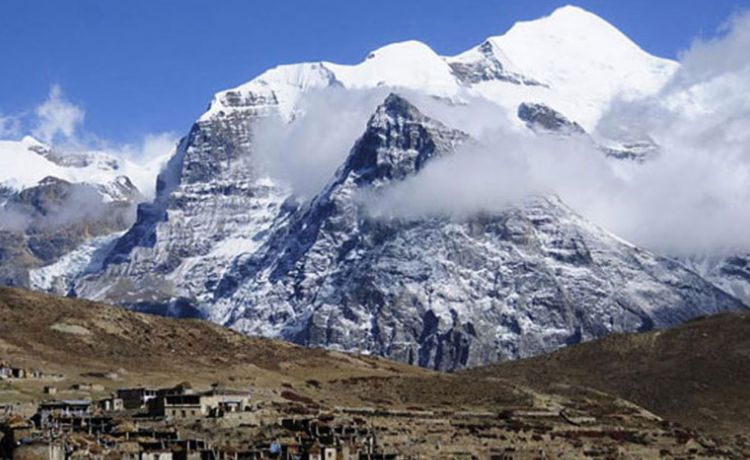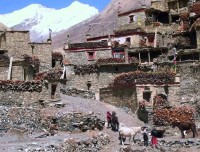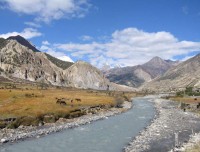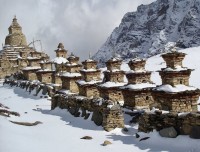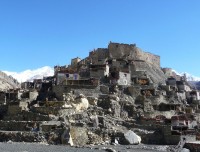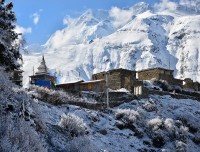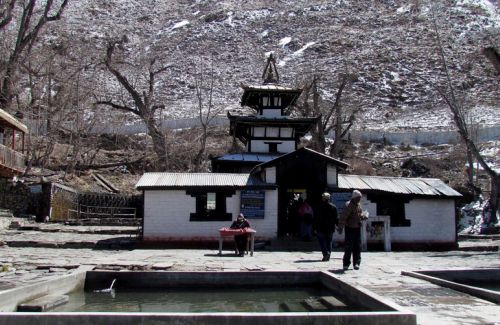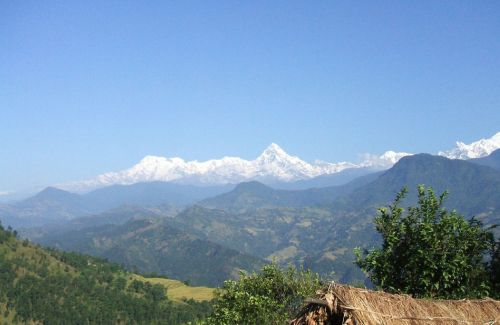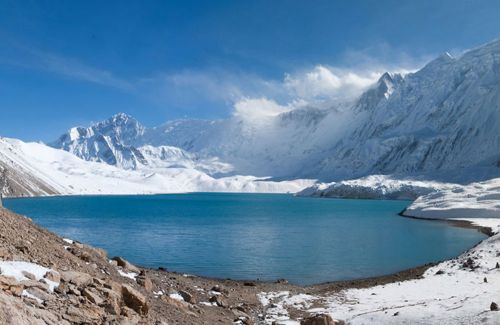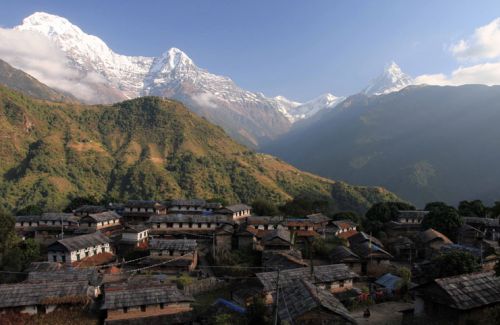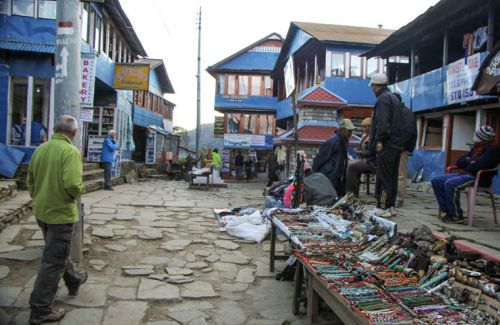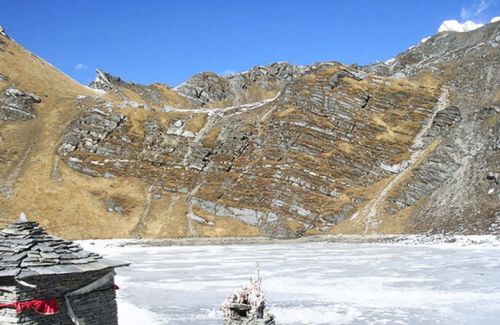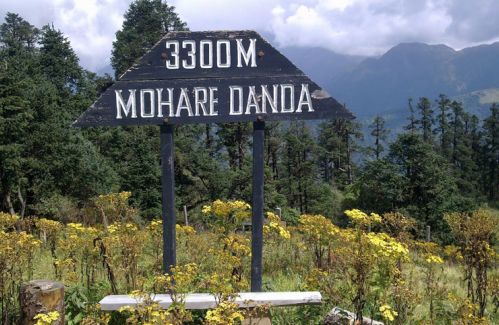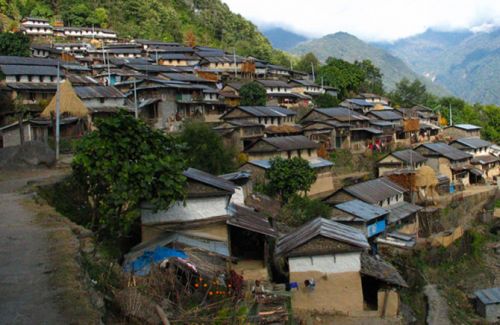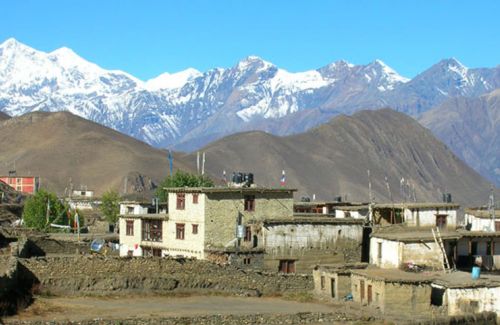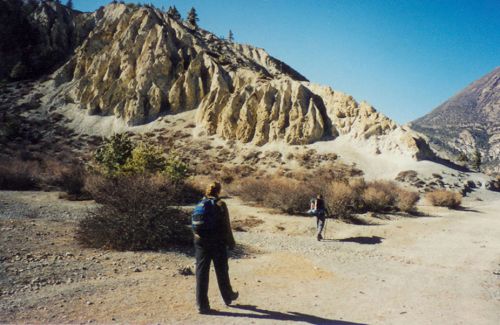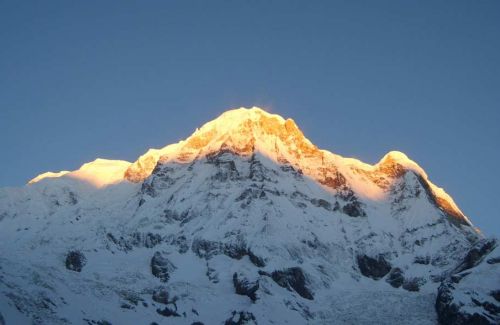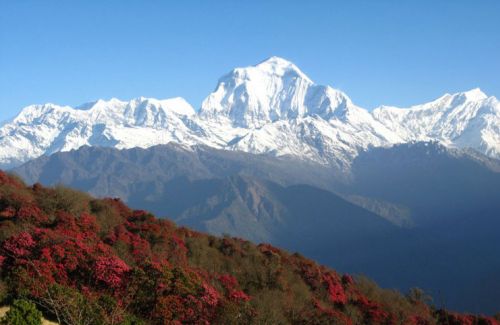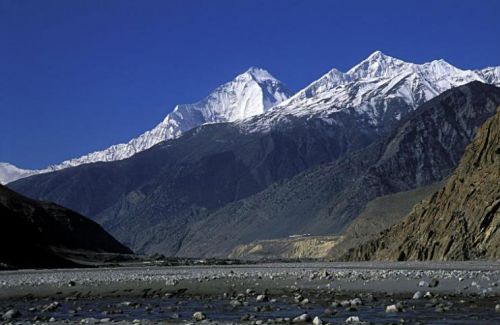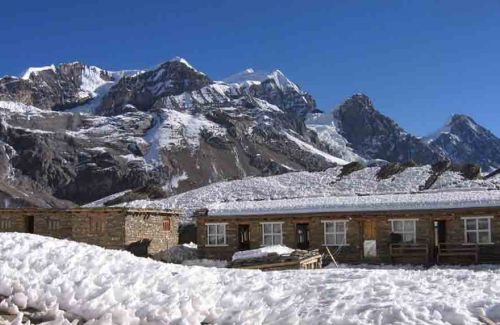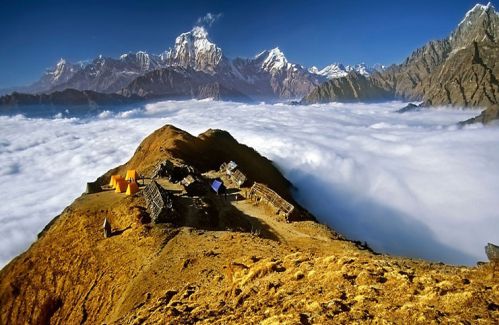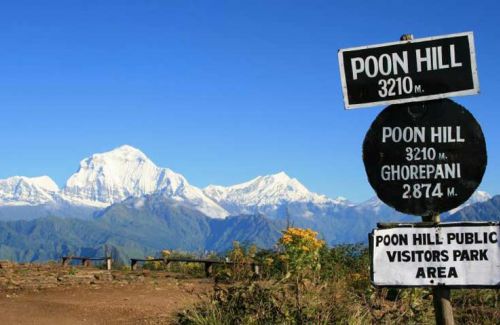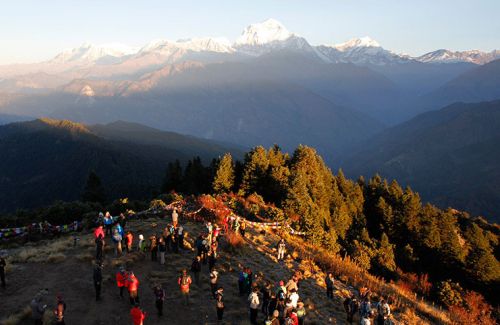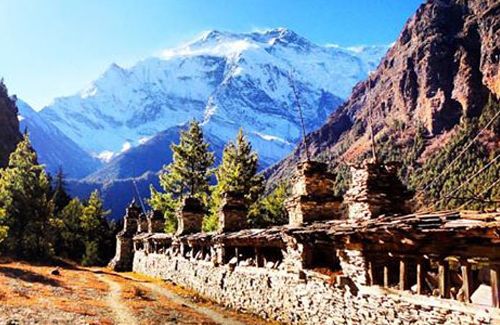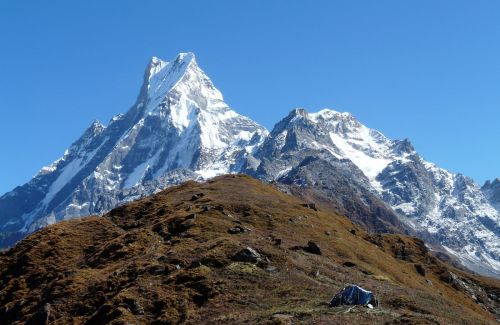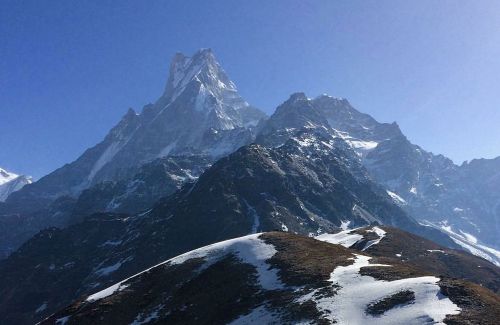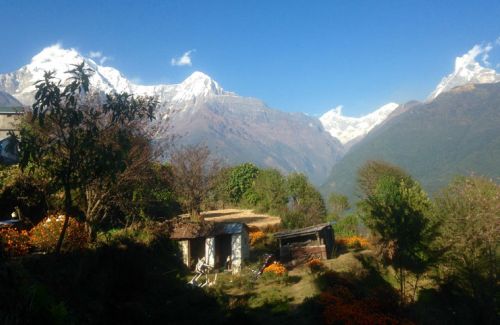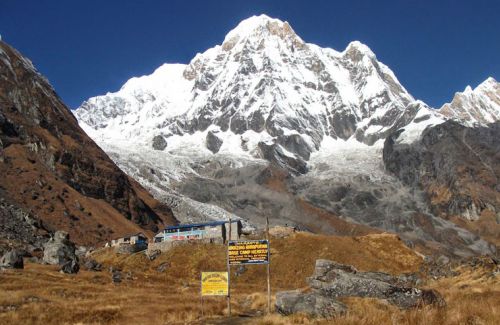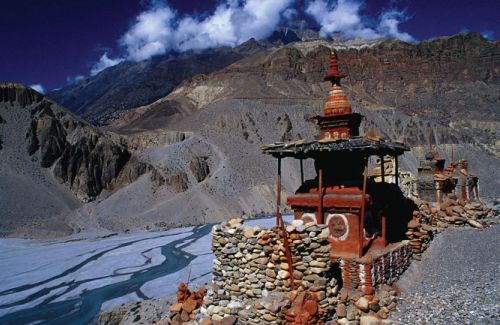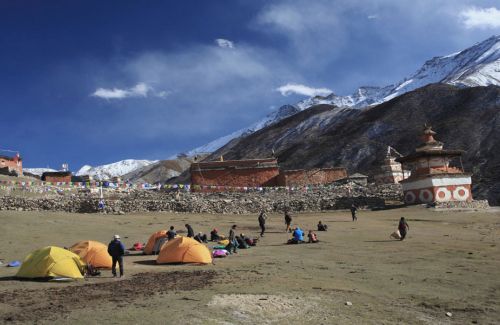Nar Phu Valley Trekking
- Duration17 Days
- Max. Altitude5,099 m
- Starts FromUSD 1525
Destination:Nepal
Trip Grade:Strenuous (****)
Meals:Breakfast + Lunch + Dinner
Transportation:Private Vehicle / Aeroplane
Accommodation:Lodge
Trekking Region:Annapurna Region
Show AllNar Phu Valley Trekking is also the newly opened trail in Annapurna Region. Nar Phu Valley Trek was explored for the outsiders only in 2003. Trek Nar Phu Valley is one of the best trekking trail for the majestic mountain views from the highlands. The Phu is the most beautiful medieval village where one can get great opportunity to learn Bhotias culture and their life style. Nar Phu Valley trek gives an immense pleasure while going though narrow canyons, glaciers, lovely forests, wonderful rock formations and the Kang La Pass.
This is the trek to the remote Nar and Phu Villages which are embroidered by many facets of natural gifts and old aged human civilization, their culture , ancient monasteries, grazing pasture lands and the dot look like yaks around there. There are about 300 inhabitants dwelling in this valley. All of they rely on their livestock. These people have not felt any effect of modernization and still lagging behind. Yak herding is the main occupation.
Nar Phu Trek is situated in the Annapurna Circuit Trekking Region. We can begin our trek from Beshishahar at Lamjung, go to Chame in Manang and to Nar Phu. Chame Koto Village is the main starting gate for the Nar Phu Valley. We can cross the Kang la Pass (5,200m) then continue the trek to Thorong La pass via Manang Village. We can either retrace back the same route or go over the Thorong La Pass and end in Jomsom. Either we can fly from Jomsom to Pokhara or trek to Nayapul then drive to Pokhara.The Annapurna Conservation Area Project has recently extended its network to include Nar Phu valley for its overall development to make this valley one of the best tourist destination.
Trip Highlights
- Full day sightseeing in UNESCO World Heritage Sites
- Exciting drive from Kathmandu to Beshishahar
- Enjoying the panoramic view of rural landscape
- Walking through Trans-Himalayan belt viewing splendid mountains
- Meeting with Tibetan Buddhist people and Bon culture followers
- Experience the hidden Valley hiking
- Cross three high passes above 5000 m.
- Feel the real , unaffected pastoral life style of the Nar Phu Villagers.
- Learn the Monastic culture
Day to Day Itinerary
Day 01:Arrival in Kathmandu (1,350 m)and Transfer to Hotel. Overnight at Hotel
Day 02:Pre-Trip Meeting and Sightseeing in Kathmandu Valley, Trek Preparation. O/N at Hotel
Day 03:Drive from Kathmandu to Besishahar (823 m), 6-7 hrs, then drive to Chamje (1,310 m), 3 hrs. O/N at Guest House
Day 04:Trek from Chamje to Dharapani (1,920 m), 6 hrs. O/N at Guest House
Day 05:Trek from Dharapani to Koto (2,600 m), 5 hrs. O/N at Guest House
Day 06:Trek from Koto to Meta (3,230 m), 7-8 hrs. O/N at Guest House
Day 07:Trek from Meta to Phu Village (4,050 m), 7-8 hrs. O/N at Guest House
Day 08:Explore Phu Village and Monastery
Day 09:Hike to Himlung Base Camp (4,850 m), then return back to Phu Village, 7-8 hrs. O/N at Guest House
Day 10:Trek from Phu to Nar Village (4,150 m, 7-8 hrs. O.N at Guest House
Day 11:Explore Nar Village, hike nearby, and meet the local people. O/N at Guest House
Day 12:Trek from Nar - Kang La Pass - Ngawal (3,675 m), 8-9 hrs. O/N at Guest House
Day 13:Trek from Ngawal to Manang (3,550 m), 4 hrs. O/N at Guest House
Day 14:Explore around Manang, visit Gangapurna Lake, Milarepa cave etc. O/N at Guest House
Day 15:Trek from Manang to Chame (2,650 m), 7 hrs. O/N at Guest House
Day 16:Drive from Chame to Kathmandu, 8-9 hrs. O/N at Hotel
Day 17:Departure to International Airport
Cost Include
- Airport Pick-up and drop-off by private tourist vehicle
- 3 nights hotel in Kathmandu with twin sharing basis( The hotel of 2-3 star category) with breakfast
- Guided City tour with private tourist vehicle
- A government licensed holder city Tour Guide
- Lodges, Guest Houses basis accommodation during the trek
- Full board meal (Breakfast + Lunch + Dinner) during the trek
- Drive from Kathmandu - Beshishahar and from Chame - Kathmandu by local bus/Jeep
- Annapurna Conservation Area Entry Permit and TIMS Card for trekking
- Nar Phu Valley Special Permit
- An experienced English speaking Trekking Guide
- The required number of local staffs and Porter (2 Trekkers = 1 Porter)
- Food, accommodation, salary, insurance, equipment and medicine for all the staffs
- Down Jacket, Duffel Bag and Sleeping Bag by Himkala Adventure (if required)
- Farewell Dinner with Nepalese Cultural Show
- Government Taxes, VAT, and Service Charge
Cost Exclude
- Lunch and Dinner in Kathmandu
- Entrance fees in Heritage Sites and other places
- Nepal Entry Visa Fee
- Personal Expenses (telephone, battery charge, laundry, hot shower, hot or cold drinks etc.)
- Personal Trekking Equipments
- Your travel insurance
- Emergency Rescue and Evacuation
- Tips for trekking/tour staffs, driver
- Any other costs not included in ‘Cost Includes Section’
Detail Itinerary
Day 01Arrival in Kathmandu (1,350 m)and Transfer to Hotel. Overnight at HotelUpon your arrival in the International Airport in Kathmandu, our representative from Himkala Adventure will greet you in the perfect response. Then we transfer you from the airport to the hotel in Thamel which is 5 km and takes 20 minutes. After the check in hotel, you could take rest to rejuvenate from the jet lag. After this, you could explore Thamel in your leisure. Overnight in Kathmandu
Day 02Pre-Trip Meeting and Sightseeing in Kathmandu Valley, Trek Preparation. O/N at Hotel Today, after breakfast, we set out for the guided city sightseeing. First, we head towards the Swoyambhu Stupa, known as the monkey temple. This is a conical shaped hill, 77 m high from the ground level. If you are not tired, we can hike and go through 365 steps otherwise, there is easy way to be in the top. After walking around stupa and ritual activities done by the local people, we descend down to the Kathmandu Durbar Square. It has many Hindu temples, courtyards, Palaces and artistic craftsmanship. The third place is Boudha-Stupa. This is one of the biggest stupa in southern Asia and influenced by the Tibetan Buddhism, There are more than 28 monasteries around it. The fourth place is about 2 km far from Boudha is Pashupati- the famous Shiva Temple where there is a cremation spot and the dead bodies brought there, are cremated in traditional way. After the city tour, we return back to hotel and brief you about the Nar Phu Trekking that we begin from tomorrow. Overnight in Kathmandu
Day 03Drive from Kathmandu to Besishahar (823 m), 6-7 hrs, then drive to Chamje (1,310 m), 3 hrs. O/N at Guest House Today, we drive from Kathmandu to Beshishahar by bus. It is 135 km from Kathmandu to Dumre and 36 km from Dumre to Beshishahar. The road from Dumre splits and goes from the right hand side. It takes about 6-7 hours from Kathmandu to Beshishahar and from Beshishahar to Chamje, there is a jeep service which takes about 3 hours. Overnight in Chamje
Day 04Trek from Chamje to Dharapani (1,920 m), 6 hrs. O/N at Guest House After breakfast, we pass through the villages influenced very much Tibetan, said to have been migrated from Tibet since long. We cross the suspension bridge below Chamje and ascend climb steeply to reach Tal. There is blending of Gurung and Tibetan community. From the end of the valley above Tal, the trail goes up in the beginning and lowers to the Dharapani from the mountain side. Overnight in Dharapani
Day 05Trek from Dharapani to Koto (2,600 m), 5 hrs. O/N at Guest House After breakfast, we set out for Koto from Dharapani. At first, we reach to Bagarchhap passing through pine and fir trees which take about an hour. There is a white washed monastery at Bagarchhap. We continue our trek and arrive at Danaque after an hour. The path then goes steeply up to Timang and to Latamarang passing through the forest which further takes one and half an hour. We get our lunch there and continue the trek till Koto. Overnight in Koto
Day 06Trek from Koto to Meta (3,230 m), 7-8 hrs. O/N at Guest House There is a Police Check Post where we register our restricted area permit and continue our trek through the Soti Khola River bank.After going through forest, we cross the suspension bridge and reach to Dharmasala. We take a packed lunch today. After passing the forest, we climb steeply towards Meta Village.Overnight in Meta
Day 07Trek from Meta to Phu Village (4,050 m), 7-8 hrs. O/N at Guest House Today the trail fluctuates, we cross the suspension bridge over many streams. After about 4 hours trek, we arrive at Kyang where we can see the ruined forts of the Khampa settlement. Then we walk through Phu Khola and find the rocky trail. After another 3-4 hours walk, we reach to Phu village. Overnight in Phu village
Day 08Explore Phu Village and Monastery It is the day to acclimatize but not for the complete day rest. To keep fit and acclimatized with the altitude, we explore the Phu valley, its intact cultural setting; natural diversity and religious practices etc. There are three main ethnic communities like Lama, Gurung and Ghale living in harmony. We closely see the way they have been living doing agricultural work. We can visit the Tashi Lakhang Monastery.The monastery is said to have been built by the Karmapa Rinpoche and one of the 108 world’s old monastery. We can see the Himlung imal from here. Overnight in Phu Village
Day 09Hike to Himlung Base Camp (4,850 m), then return back to Phu Village, 7-8 hrs. O/N at Guest House Today is an extra day for the side trip to hike to Himlung Base Camp. The Himlung Himal is situated in the northeast of Annapurna Region at an altitude of 7,126 m. The route passes through the high peaks, passes, glaciers, remote villages, forests, rocks springs and unique cultural settlements. But we climb only up to the Himlung Base Camp at an elevation of 4,850 m. This is what we do in a day and return back to Phu village. Overnight in Phu Village
Day 10Trek from Phu to Nar Village (4,150 m, 7-8 hrs. O.N at Guest House After breakfast, we descend down to Mahendra Pul passing many streams and crossing the suspension bridges over them. It takes about 4 hours from Phu village to Mahendra Pul, 80 m long over the gorge of Lapche River. We get lunch there and begin to climb to Nar Village. We can see many Buddhist stupas. It takes about 2 hours to reach to Nar village from Mahendra Pul. Overnight in Nar Village
Day 11Explore Nar Village, hike nearby, and meet the local people. O/N at Guest House We explore Nar Village and do hiking nearby. It is the great opportunity to interact with the local people and understand about the local culture and their life style. Overnight in Nar Village
Day 12Trek from Nar - Kang La Pass - Ngawal (3,675 m), 8-9 hrs. O/N at Guest House It is the long day hike with difficult Pass. We get up early in the morning and trek to Kang La Pass. We can see the fine Annapurna ranges from the pass. We trek down to Ngwal from Kang La Pass. Overnight in Ngwal
Day 13Trek from Ngawal to Manang (3,550 m), 4 hrs. O/N at Guest House After breakfast, we set out for Manag from Ngawal. First, we pass through the Paugh Village then gently ascend uphll to Mungji where we meet the main trail of Annapurna Circuit.Finally following the mail trail, we reach to Manang. Overnight in Manang
Day 14Explore around Manang, visit Gangapurna Lake, Milarepa cave etc. O/N at Guest House Managis are rich in culture and the same way they have the strong economy too. They do trade and have proper life style. We can walk around Manang and do short hiking. There is a famous gompa located in a short walk away. We can go to see the Gangapurna Lake as well. We can visit the Milarepa Cave and Ice Lake if we have enough time. If we are lucky , we can see the horse race and the archery sport competition there. Overnight in Manang
Day 15Trek from Manang to Chame (2,650 m), 7 hrs. O/N at Guest House From Manang, we come to Braga after half an hour walk, then cross the Sabche Khola River and reach to the valley of Ongre. We climb up from there and arrive at Pisang via lower Pisang village. After this we descend .cross the bridge and reach to Bartlang after 45 minutes walk from Lower Pisang. It takes about 2 hours from Bartlang to reach Chame via the settlement of Taleku. Overnight in Chame
Day 16Drive from Chame to Kathmandu, 8-9 hrs. O/N at Hotel It is 239 km from Chame to Kathmandu. The road from Chame to Beshishahar is rough, coarse and bumpy but the road from Beshishahar to Kathmandu is well pitched and smooth through scenic countryside. After our arrival, we take a rest for a while and join for the dinner in the Typical Nepalese restaurant where we will enjoy the Nepalese cultural show. Overnight in Kathmandu
Day 17Departure to International Airport We transfer you to the International Airport 3 hours before your scheduled flight so that you could have enough time for managing your luggage, things gets x-rayed and take a boarding pass. We would like to thank you that you joined Himkala Adventure for the Nar Phu Trekking and depart from the airport wishing your safe journey towards the next destination. Namaste!!!
Trip FAQ
Himkala Adventure would like to quench the thirst of all necessary questions answers about Nar Phu Valley Trekking for all curious travelers/trekkers in the world. As you are entirely from different geographical location, you could better to know everything about the treks from the beginning i.e. airport pick up till your departure like airport picks up, drops off, accommodation in city, in the trek, guide and porters, safety for the trekking, food and accommodation and some other things that you might face on the way. Hope our endeavor listing these questions answers will help you self informed.
This is simply the outlines of the services we offer but it may differ as per your requirement, number of trekkers. What we go through our conversation, we will manage the means of transportation, hotels in the city, accommodation in the trekking, numbers of porters etc. This is general idea about Nar Phu Valley Trekking before your trip and you become clearer about the trek. Please feel free to contact us to get more information about the trekking in the Himalayas of Nepal.
1) How is Nar Phy Valley Trekking in Nepal?
Nar Phu Valley Trekking is an alternativer trekking trail of Annapurna Region in the western part of Nepal.The newly explored trek reaches up to 5,099 m from the sea level. It is a strenous trek and needs physical stamina. Nar Phu Valley has about 300 inhabitants who depend on livestock, unlike most Bhotia people, whose trading patterns changed drastically after the Nepali Government closed borders with Tibet, the people of Nar and Phu valley were least affected by this change. The torturous path leading from the valley into Tibet had never made them dependent on the salt trade, and till today, yak herding is the basis of their livelihood. This trek goes over the Kang La Pass (5200 m) and join with Annapurna Circuit.
2) What physical fitness do I need to book this trip?
Every trekking in the Himalayas of Nepal require the certain level of physical and mental fitness.So, we advise you to be in good physical shape and able to feel comfortable while hiking up and down 7 to 12 miles per day on a trail carrying a day pack of about 10 pounds. Three things could make you confident enough for any trek you would like to do: aerobic, strength and mental.
Aerobic conditioning is important primarily because you will be trekking in thinner air, up to 40% less than at sea level. With good aerobic conditioning, you will be able to better metabolize whatever oxygen is available to you. You should plan on doing at least one hour of aerobic 3 /4 times per week for 1 month or more before your arrival in Nepal. Walking, jogging, cycling, hiking on valley floor to ridge line ascents with day back are some of the excellent forms of exercise, so long as you are strengthening leg muscles and building stamina. Speed is not the essence; stamina, confidence and continuity are.
3) How do I find Himkala Adventure for my pick up at the airport?
Our representative from Himkala Adventure will display a small board of company or your name on the sheet of paper outside the airport terminal. You will be driven to the hotel by our tourist vehicle.
4) What sort of accommodation do I get in Kathmandu and Pokhara ?
Normally we provide standard rooms with twin sharing accommodations at three star or similar category hotels in Kathmandu and Pokhara including breakfast. Accommodation in these cities can be upgraded as per your request. But some of our packages are sold without accommodation in the city.
5) How are tea house facilities during Nar Phu Valley Trekking?
Tea House is the combination of guest house, restaurant, and social hang out. Tea houses in Mardi Himal Trekking area are highly professional though they are simple but with neat and clean lodging offering fine views and plain but fresh and hygienic food with friendly atmosphere Most of the Tea Houses have running water facility. Many of them have hot water available for bathing. But we discourage our groups from using water heated by wood as lack of firewood in most villages is a big environmental concern in Nepal.
6) What sort of accommodation do I get in trekking?
Guesthouses/Tea Houses/Lodges provide twin sharing single and double rooms and occasionally a dormitory which is basically clean with a mattress and a quilt or blanket. Our company provides the sleeping bag if needed but we always recommend having your own sleeping equipments. You have to share the room with your group member or sometimes with unknown traveler. The toilet is always outside the room with basic facilities.
7) What sort of foods, water and drinks can I expect in trekking?
The foods in the Himalayas are very simple. There are mostly the family members themselves to cook and serve the meal. They are simply trained but experienced because they have been offering such services for many years in this busy route. The food is hygienic, fresh and delicious. We recommend you to drink mineral water or the boiled or using water purification pills or drops.
Most of the foods are cooked in the kitchen of tea houses. They serve you with different varieties of delicious Nepali and continental dishes. The most popular Nepali food is daal bhat (rice and lentils) with some mixed vegetable curry. Garlic soup is popular as it helps you with acclimatization. You could better be vegetarian in the mountains. All hotels in cities and guesthouses in trekking serve the vegetarian food. You can find all common types of drinks like hot chocolates, coffee, tea, hot lemon with honey, ginger tea, soft drinks etc. you will have your breakfast and dinner at the lodges where you will be staying and lunch somewhere on the way to your next destination.
8) What mode of transportation do I use?
We will provide the private transportation for Airport/Hotel/Airport pick up and drop and sightseeing in Kathmandu Valley. We use transportation as based on our cost inclusion section. The transportation varies depending on your requirements at the time of booking the trip.
9) What is the best season for this trekking?
The best season for Nar Phu Valley Trekking is spring (March to May) and autumn (September to December). These are the perfect time of the year for the breathtaking views of Himalayas with clear and sunny days. But the weather in the mountains is unpredictable.
10) What is the weather and temperature like during the trekking?
The climate in Nepal varies from place to place which can be categorized in different four main seasons. The main seasons in Nepal are spring (March to May), summer (June to August), autumn (September to November) & winter (December to February). The best season to travel in Nepal is autumn (September, October & November) & spring (March, April & May). Weather in the mountains is unpredictable. But the day temperature in Nar Phu Valley Trekking is comfortable.
11) Who will be guiding me during this trip?
We provide the professional government license holder English speaking trekking guides for our entire trekking trip. We can also provide French, Spanish, Japanese, German or Italian speaking guides as per your preference with extra payment but not guaranteed. All guides will be Nepali people who are carefully selected on the basis of their appropriate experience, leadership skills and personality. They are all trained from Nepal Academy of Tourism and Hotel Management, certified and approved by the Tourism Department of Nepal government. We provide a different city tour guide to guide you in UNESCO World Heritage Sites in Kathmandu. They are the professional license holder guide specialized in culture, history, geography, iconography, archeology and religion with good command over English. Tour guides are specialized in city tour and trekking guides are more in the hiking and trekking in the Himalayas.
12) What sort of experience do your guides have?
Our entire city tour guides have bachelors to Master Degree academic education along with many months tour guiding training from Nepal Academy of Tourism and Hotel Management, Rabi Bhawan, Kathmandu, Nepal. They are fluent in spoken languages and informative about the sites in many aspects. They are quite experienced and dedicated to their job and responsibilities.
Our entire trekking guides have minimum Intermediate to Master Degree academic education with trekking guide training from Nepal Academy of Tourism and Hotel Management, Rabi Bhawan, Kathmandu, Nepal. Many of them are from villages. As they are local, they know more about the routes, necessary precaution to be taken and so on. They have spent many years exploring many parts of the country. They are trained in first aid and able to handle any situation easily. They speak good English and make you know about the places you visit.
13) May I charge my electronic gadgets during Nar Phu Valley Trekking?
Most of the places in your tea houses have charging facilities. You can charge your devices by paying some extra money. It’s good if you bring TWO or THREE pin travel adapter and put your gadgets at warm place at night.
14) How much additional money is required for this trip?
It’s a very personal question as expenses depend on habit. Normally, in Kathmandu you can allocate about USD 10 to 15 per person per lunch or dinner. USD 10 to USD 15 per person per day will be sufficient to buy bottles of water, chocolates, pay for a hot shower during the trekking. Other personal expenses will be your own calculation.
15) What is the social and environmental responsibility of Himkala Adventure for this trip?
The situation of environment in Nepal is in considerable stage due to so many factors caused by global warming, human activities, and adverse effects of natural incidents. Nepal is in between two giant countries like China and Nepal. The ozone layer is depleting and the atmosphere is getting heated. So, its direct effect is to the Himalayas that the snow is melting day by day and the sea level is rising. It is due to population growth, people are clearing the forest and the soil is being eroded. As a part of society, and our trekking related activities are directly concerned with the social and environmental things. We are very conscious not litter in the open spaces, to manage garbage properly and make local people aware in this campaign. We are working together with other companies and taking these issues seriously.
16) What is the minimum number requirement for this trip?
We operate individual trip to the group joining trips for Nar Phu Valley Trekking. If you want to do any private trip we are ready to organize for solo traveler as well with some additional charges.
17) Are there communication or internet services during Nar Phu Valley Trekking?
All guesthouses/lodges in Nar Phu Valley Trekking trails have telephones and internet services. They provide the WIFI service with some extra charge which helps to get updated with social Medias, friends or family. All our guides carry the local mobile phone. You can use his mobile phone to make any local or international call from trekking trails by paying him directly. You can even pass him number to be connected with your family or friends. We highly recommend taking local SIM card for call and internet services during trekking. Local SIM cards are easily available in many stores and at airport as well. You need to provide two copies of your photographs and your passport copy to get local SIM CARDS of NCELL & NTC (only these two companies provide telephone services in Nepal
18) May I get chances for shower during Nar Phu Valley Trekking?
Most of the guesthouse provides hot shower with some extra cost. In few places, bucket water will be provided for the shower.
19) May I add extra days in trekking?
We are ready to operate your holidays as per your interest and requirements. You can spend extra days on your loving or favorable places or even can make it shorter. We will always do our best to manage your hotel bookings, flight booking and everything.
20) What happens in case of emergency?
Himkala Adventure has prepared for any emergency situation and knows how to handle it. Our guides are trained in first aid and can deal with most of the basic ailments that occur during the trek. Every client should have his own insurance before coming to Nepal for the case of emergency.
21) Do I need to have insurance for this trip?
We request you to have a travel-insurance policy to cover theft, loss, medical problem & emergency helicopter evacuation from high altitude places before coming Nepal. Choose a policy to cover your emergency high altitude helicopter evacuation with all medical insurances for trekking in high altitude in the Himalayas of Nepal. Your travel insurance is always needed before going in any high altitude trekking. Please check your travel insurance policy which doesn’t exclude mountaineering or alpinism. Although you will not be engaging in these activities in your trekking, you might have problem convincing the insurance company of this fact. Rescue insurance need to cover an emergency helicopter evacuation or a charted flight from remote mountain trails of Nepal as well as international medical evacuation. A helicopter evacuation might cost US$ 2500 to US$10000 depending on the places. So that travel insurance to cover all above is must to travel in the high Himalayas of Nepal.
22) What is the baggage allowance from/to Kathmandu – Pokhara flight?
One can fly from Kathmandu to Pokhara. It is scenic flight over the mountains which takes 25 minutes.Normally, it is 20 kg free allowed per head flying from/to Kathmandu – Pokhara flight. If we have bought tickets in a group then it calculates member and multiply 20 X ..., rest we need to pay approximately USD 1 per Kg. They allow up to 7 kg for the hand carry.
23) What type of shoes should I wear during Nar Phu Valley Trekking?
You could better have carefully chosen hiking boots which should be kind of strong, well-made but light boots for Mardi Himal Trekking. Shoes and boots are best to buy before arriving in Nepal. We advise you to wear your new shoes for sometime before trek so that you could feel well habituated on the newer trail for your feet.
24) Can I use credit cards in the Nar Phu Valley Trekking route?
Of course not, you can use only in the cities like Kathmandu, Pokhara but not in Nar Phu Valley Trekking route. When you are out of city, all you need is cash, better to have small notes. Please change the currency in local Nepali rupees before you go to the mountains.
25) Do I need to tip my guide and porter? How much would that be?
Tipping is not mandatory, neither it is right to ask by anyone but it is a way of showing gratitude after taking service. The level of tip also shows how satisfy you are from the team that you had been during your tour/trek.However, we recommend you to spend minimum 10% of your total trip cost for tipping entire local staffs, the ratio of tipping guide and porter will be given to you at the pre-trip meeting in Kathmandu before starting the trek.
Trip Note
Cost:
The cost of trip varies according to the number of travelers in the group, the category of the Hotel, mode of the transportation and any kind of changes (if there is). So, if you would let us know all of these above mentioned things, then we could quote you the exact price.
Essential Documents:
You are requested to send the following documents after you confirm or book the trip with Himkala Adventure:
A copy of your passport and travel/health insurance documents with contact details, three passport size photos.
It is advised to maintain a separate photocopy of all important documents including traveler’s cheques, bank/ATM card, contact numbers, international flight tickets, and emergency contact numbers.
Weather:
The main trekking season in Nepal is from October to December and March to May. The day temperature for walking to Nar Phu Valley is comfortable. The sky is clear although there is snow and rainfall occasionally. It is about 10 degree centigrade at the height of 3,600 m and increasingly lower, the higher we go.
Nepal Strikes:
There is much more progress in the political scenario in Nepal and we assure you that travelling in Nepal is safe. But there may be Bandha (wide transport strikes) at a very short notice. The shuttle bus is in operation by Nepal Tourism Board and the Nepal Tourist Police in conjunction with the Himalayan Rescue Association from domestic and international terminal to the various hotels in Kathmandu. The service costs 300 rupees per person.
Itinerary Disclaimer:
Himkala has thoughtfully designed all the itineraries but our itineraries are updated for the betterment on the basis of our past travelers’ comments and our own research. In case you find changes in the itinerary you printed and the upgraded one does not affect your trip. Please note that some changes may occur in our itineraries due to bad weather and common seasonal changes to timetables and transport routes.
Physical Rating:
Your trip will be meaningful if you could find yourself fit and fine. You will be walking up to 5,099 m from the sea level. As the geographical region varies, there is a temperature variation as well. So, we advise you to undertake regular physical exercise, jogging, hiking, riding, ascending and descending the long stairs etc. Precautions and acclimatization are undertaken but be aware of the effects altitudes can have.
Group Size:
Himkala Adventure organizes solo to group travelers. Our group trips are designed for sharing accommodation and there is no single supplement. Single travelers share with the same gender from twin to multi-share in an accommodation. You are requested to have mutual understanding in between the fellow travelers who have joined from the different parts of the world. Please remember that you have great responsibilities in the group. If you are requested to be at a particular place at a certain time, make sure that you have been there at a time. It is much more pleasing sharing experiences and traveling together.
Accommodation and Meals:
Accommodation and Foods in the Himalayan region of Nepal cannot be compared with any developed countries in the world. We know that you might not have experienced such things before but you should take it easy. Accommodations at local lodges are simple but clean and comfortable. The food is plain. Toilets and washing facilities are shared and rudimentary. In high altitude regions, there are very few tea houses and one has to be happy to share in simple dormitories without electricity, without running water. Hot shower means a bucket of hot water upon our request.
Money Matters:
Please note that most establishments in Asia will not accept foreign currency notes that are old, torn or faded and they can be very difficult to exchange or extra fees added when exchanging at banks. Please ensure that you have new, clean notes.
The official currency of Nepal is the Nepali Rupee (NPR). ATMs can be found only in major cities of Nepal like Kathmandu, Pokhara, Chitwan, Bhaktapur etc. The government of Nepal has banned the import, export and use of 500 and 1000 Indian rupee notes in Nepal. You make sure that you won’t carry these notes upon arrival in Nepal, otherwise they are confiscated and you may be fined.
Please make sure that the foreign currency notes that you have are new and clean notes because old, torn or faded foreign currency notes in Nepal are very difficult to exchange or extra fees added when exchanging at banks.
While travelers cheques have security advantages exchanging them can be a lengthy process, commissions can be high (up to 10%) and they can be difficult to change in rural areas, on weekends and public holidays. If you choose to bring travelers’ cheques, make sure they are a major brand and major currency.
Tipping:
Tipping is not mandatory. It is not anyone’s right asking for tips but if you are happy with the service, you could tip the staffs. It is entirely a personal preference. Tipping could be significant to them who took take great care of you in your traveling period. Himkala recommends that you could tip any intended recipient by any member of the group than collected and passed on by the group leader.
Note: Please do not tip with coins or dirty and ripped notes. This is culturally taken as an insult.
Local Dress in Nepal:
Nudity is a sensitive issue in Nepal. Women should avoid wearing shorts and sleeveless tops in public places where this might be seen as inappropriate. Remove shoes before entering certain holy places. Non-Hindus are not permitted in some temples.
Feedback:
Your feedback will be the great guidance to meet our target and to bring improvement in our service. What and how have you experienced with Himkala Adventure and our staff? Please write, we will read it carefully. One cannot see his/her shortcomings that are lying with them. Someone should point it out. We are always eager to hear from you.
Trip Info
- Weather
- Trip Grading
- Accommodation/Shelter
- Altitude Sickness
- Communications and Updates
- Conservation
- Cross Cultural Issues
- Essential Do’s and Don’ts
- Foot Ware/Foot Care
- Health and Fitness
- Himkala Crews
- Hypothermia
- Safety and Security
- Travel Insurance and Evacuation
- Trip FAQs
- Washing and Shower
- Water/Food and Nutrition
- Equipment List
